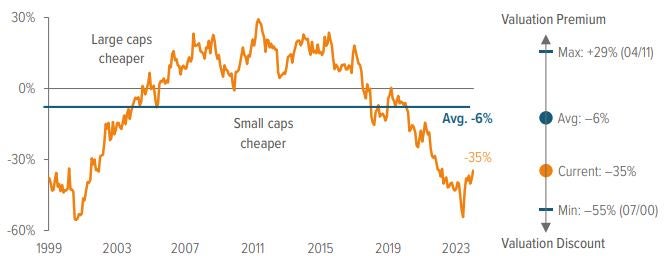
Compared to their larger peers, small caps are at discounts not seen since the dotcom bubble, creating compelling opportunities in high-quality growth businesses that can thrive despite higher financing costs.
U.S. small cap growth stocks have historically traded at a slight discount to large caps, but today’s markdown is especially steep. Excluding the recent period, small caps haven’t traded at current levels since the dotcom bubble burst in 2001 (Exhibit 1).

As of 12/29/23. Source: FTSE Russell, Voya IM. The chart shows the relative forward price-to-earnings (P/E) of the Russell 2000 Growth Index divided by that of the Russell 1000 Growth Index. See disclosures for index definitions.
So, what happened to push relative valuations to these levels? Two words: interest rates. The roughly 4.1% rise in the 10–year Treasury yield, which peaked at 5.0% in October 2023, has been particularly jarring for small companies. Longer–duration assets, including small cap growth companies, tend to see significant valuation pressure in high interest rate environments. Additionally, since small companies rely more heavily on variable–rate debt, their cost of capital rises as interest rates increase.
How we invest in small caps when borrowing costs are high
We believe focusing on companies that can deliver strong organic growth without substantial need for outside financing should mitigate this impact. That’s why active, fundamental analysis matters.
Furthermore, slower growth expectations are largely reflected in small cap stock prices and forward earnings. This year’s earnings growth estimates for small cap growth companies average 10.0%, compared with 14.2% for large cap growth companies.1 While the slower growth outlook for smaller businesses may deter some investors, we believe the valuation discount being offered by small caps will allow investors to benefit from reaccelerating fundamentals, with limited downside versus large caps. And should the Fed cut rates in 2024, as the market expects, the potential for a declining cost of capital should close this valuation gap—another reason now may be an opportune time to invest in small cap growth.
Learn more about the opportunity in small caps.
Risks of Investing The principal risks are generally those attributable to investing in stocks and related derivative instruments. Holdings are subject to market, issuer and other risks, and their values may fluctuate. Market risk is the risk that securities or other instruments may decline in value due to factors affecting the securities markets or particular industries. Issuer risk is the risk that the value of a security or instrument may decline for reasons specific to the issuer, such as changes in its financial condition. More particularly, the strategy invests in smaller companies which may be more susceptible to price swings than larger companies because they have fewer resources and more limited products, and many are dependent on a few key managers. |

